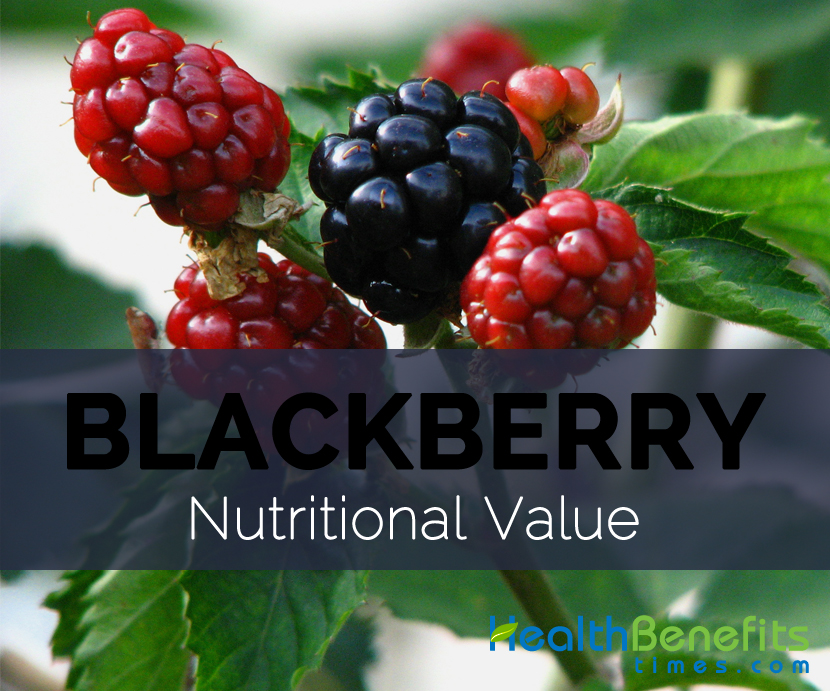 Apart from their wonderful and sweet taste, Blackberry is a good source of nutrients, minerals, vitamins. Consuming 144 gram of this fruit supplies, 0.93 mg of Manganese, 30.2 mg of Vitamin C, 0.238 mg of Copper, 28.5 µg of Vitamin K, 7.6 g of Total dietary fiber, 1.68 mg of Vitamin E, 0.89 mg of Iron. Moreover many Lipids like 0.02 g of Fatty acids, total saturated, , 0.017g of Palmitic acids, 0.004g of Stearic acids are also found in 100 gram of the fruit.
Apart from their wonderful and sweet taste, Blackberry is a good source of nutrients, minerals, vitamins. Consuming 144 gram of this fruit supplies, 0.93 mg of Manganese, 30.2 mg of Vitamin C, 0.238 mg of Copper, 28.5 µg of Vitamin K, 7.6 g of Total dietary fiber, 1.68 mg of Vitamin E, 0.89 mg of Iron. Moreover many Lipids like 0.02 g of Fatty acids, total saturated, , 0.017g of Palmitic acids, 0.004g of Stearic acids are also found in 100 gram of the fruit.
Nutritional value of Blackberries
Serving Size: 1 Cup (144 g)
Calories 62 Kcal. Calories from Fat 6.39 Kcal.
| Proximity | Amount | % DV |
|---|---|---|
| Water | 126.94 g | |
| Energy | 62 Kcal | |
| Energy | 261 kJ | |
| Protein | 2 g | 4.00% |
| Total Fat (lipid) | 0.71 g | 2.03% |
| Ash | 0.53 g | |
| Carbohydrate | 13.84 g | 10.65% |
| Total dietary Fiber | 7.6 g | 20.00% |
| Total Sugars | 7.03 g | |
| Sucrose | 0.1 g | |
| Glucose (dextrose) | 3.33 g | |
| Fructose | 3.46 g | |
| Maltose | 0.1 g | |
| Galactose | 0.04 g |
| Minerals | Amount | % DV |
|---|---|---|
| Calcium, Ca | 42 mg | 4.20% |
| Iron, Fe | 0.89 mg | 11.13% |
| Magnesium, Mg | 29 mg | 6.90% |
| Phosphorus, P | 32 mg | 4.57% |
| Potassium, K | 233 mg | 4.96% |
| Sodium, Na | 1 mg | 0.07% |
| Zinc, Zn | 0.76 mg | 6.91% |
| Copper, Cu | 0.238 mg | 26.44% |
| Manganese, Mn | 0.93 mg | 40.43% |
| Selenium, Se | 0.6 µg | 1.09% |
| Vitamins | Amount | % DV |
|---|---|---|
| Vitamin C (Ascorbic acid) | 30.2 mg | 33.56% |
| Vitamin B1 (Thiamin) | 0.029 mg | 2.42% |
| Vitamin B2 (Riboflavin) | 0.037 mg | 2.85% |
| Vitamin B3 (Niacin) | 0.93 mg | 5.81% |
| Vitamin B5 (Pantothenic acid) | 0.397 mg | 7.94% |
| Vitamin B6 (Pyridoxine) | 0.043 mg | 3.31% |
| Vitamin B9 (Folate, Folic acid) | 36 µg | 9.00% |
| Choline | 12.2 mg | 2.22% |
| Vitamin A | 16 µg | 2.29% |
| Beta Carotene | 184 µg | |
| Betaine | 0.4 mg | |
| Lutein + zeaxanthin | 170 µg | |
| Vitamin E (alpha-tocopherol) | 1.68 mg | 11.20% |
| Vitamin K (phylloquinone) | 28.5 µg | 23.75% |
| Lipids | Amount | % DV |
|---|---|---|
| Fatty acids, total saturated | 0.02 g | 0.03% |
| Palmitic acid (hexadecanoic acid) | 0.017 g | |
| Stearic acid (octadecanoic acid) | 0.004 g | |
| Fatty acids, total monounsaturated | 0.068 g | |
| Oleic acid (octadecenoic acid) | 0.063 g | |
| Gadoleic acid (eicosenoic acid) | 0.006 g | |
| Fatty acids, total polyunsaturated | 0.403 g | 2.37% |
| Linoleic acid (octadecadienoic acid) | 0.268 g | |
| Linolenic acid (Octadecatrienoic acid) | 0.135 g |
| Flavonoids | Amount | % DV |
|---|---|---|
| Anthocyanidins | ||
| Cyanidin | 143.93 mg | |
| Pelargonidin | 0.6 mg | |
| Peonidin | 0.3 mg | |
| Flavan-3-ols | ||
| (+)-Catechin | 53.4 mg | |
| (-)-Epigallocatechin | 0.1 mg | |
| (-)-Epicatechin | 6.7 mg | |
| (-)-Epigallocatechin 3-gallate | 1 mg | |
| Flavonols | ||
| Kaempferol | 0.4 mg | |
| Myricetin | 1 mg | |
| Quercetin | 5.2 mg | |
| Proanthocyanidin | ||
| Proanthocyanidin dimers | 6.4 mg | |
| Proanthocyanidin trimers | 3 mg | |
| Proanthocyanidin 4-6mers | 10.5 mg | |
| Proanthocyanidin 7-10mers | 6.1 mg | |
| Proanthocyanidin polymers (>10mers) | 2.2 mg |
*Percent Daily values are based on 2,000 calorie diet. Your daily values may be higher or lower depending on your calorie needs.
Source: USDA

